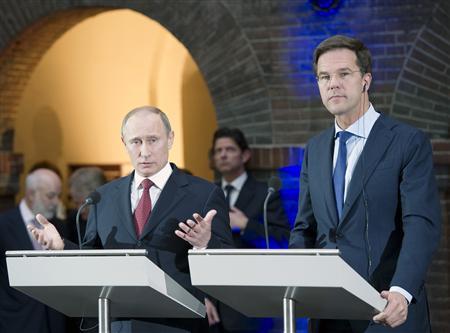
Russia Plans Massive Expansion of Nord Stream Pipelines
Publication: Eurasia Daily Monitor Volume: 10 Issue: 68
By:

On April 8 in Amsterdam, Russian President Vladimir Putin and Dutch Prime Minister Mark Rutte witnessed the signing of an agreement of intent to expand the Gazprom-controlled Nord Stream pipeline system into the Netherlands and potentially onward to the United Kingdom. The CEOs of Gazprom and of Nederlandse Gasunie, Aleksei Miller and Paul van Gelder, respectively, signed the document, following Putin and Miller’s recently announced initiative to expand Nord Stream.
This intention forms part of a vast program of building new export pipelines (Nord Stream Three and Four, “Yamal Two,” South Stream—see EDM, April 5), which in combination with existing capacities would far exceed Russia’s foreseeable gas export possibilities to Europe, or any foreseeable European demand for Russian gas. It can only begin to make some sense if Russia totally stops using Ukraine’s transit system—a possibility to which Moscow has begun to allude in order to intimidate Ukraine (East European Gas Analysis, April 7).
The Groningen-based, state-owned Gasunie is a minority shareholder in the Gazprom-led Nord Stream consortium (see below). The proposed expansion of Nord Stream would add (in sequence) a third and a fourth line to its existing two lines on the Baltic seabed from Russia to Germany; it would reach the Netherlands with those new lines; and it would use the fourth line to deliver gas to Britain through an existing pipeline on the seabed of the North Sea. The third and fourth lines are planned for annual capacities of 27.5 billion cubic meters (bcm) each, equal to the existing capacities of Nord Stream One and Nord Stream Two. Thus the system’s overall capacity would double from 55 bcm to 110 bcm per year.
While Nord Stream One and Two are owned and operated by the Gazprom-controlled consortium along the entire route on the Baltic seabed, the proposed new lines would be governed by Gazprom-led joint ventures or consortiums for each distinct segment along the route (resembling the South Stream project’s model) (Gazprom press release, April 8; Interfax, April 8, 9; Kommersant, April 9).
On his return from the Netherlands, Miller told a Nord Stream shareholders’ meeting that Gazprom would wait at least six months before signing any binding documents on Nord Stream Three (Interfax, April 9). He was apparently alluding to decisions yet to be taken about sequencing or prioritizing Russia’s multiple export pipeline projects (see above). On April 4, Russia’s Natural Resources Ministry informed each country riparian to the Baltic Sea that the Nord Stream project company has started the environmental impact assessment study for the third and fourth lines of Nord Stream (Interfax, April 4).
The Nord Stream consortium is comprised of Gazprom with 51 percent of the shares, the German Wintershall and E.ON Ruhrgas with 15.5 percent each, and Gaz de France and Nederlandse Gasunie with 9 percent each. The existing two offshore lines, from Russia’s end of the Baltic Sea to Greifswald on the German littoral, cost (officially) €5.7 billion ($7.5 billion) to build from 2005 to 2012. The first gas flowed through Nord Stream One in November 2011 and through Nord Stream Two in October 2012. Both lines have carried, thus far, only 17.5 bcm in toto, according to Gazprom. Thus, the system operates at approximately one third of its capacity at present (Interfax, April 2).
Yet, Moscow proposes to (literally) double down on Nord Stream, and moreover to do so simultaneously with the other export pipeline projects. Gazprom is in preliminary talks since 2012 with BP about supplying Britain with Russian gas. Gazprom’s stated ambition is to increase deliveries to Britain from the present annualized rate of 8 bcm (mostly on spot market contracts) to 40 bcm through Nord Stream’s fourth line (Kommersant, April 3, 9). For those deliveries, however, Gazprom wants long-term contracts (as opposed to spot market deals) with British importers. This, according to Miller, is “a key issue” (Interfax, April 9).
Gazprom had initiated this discussion with BP and Centrica (British Gas, Scottish Gas) in 2007–2008, in close connection with Gasunie’s admission into the Nord Stream consortium and putative transit of Russian gas through the Netherlands. The Dutch then-Prime Minister Jan Peter Balkenende and Putin had witnessed that signing (see EDM, November 9, 2007). Since then, however, liquefied natural gas (LNG) and liquefied shale gas from the United States do not leave much scope in Britain for Russian pipeline-delivered gas. Exemplifying the prevailing trend, Centrica recently signed an agreement with US company Cheniere Energy on liquefied shale gas supply from the Sabine Pass LNG Terminal (in Louisiana) to the UK for the next 20 years (www.naturalgaseurope.com, March 22). Whether the limited scope for Nord Stream gas in Britain could justify massive investments in new pipeline construction is far from certain.
In Amsterdam, Putin and Miller discussed possible transit routes of Russian gas to the UK through the proposed Nord Stream system in the Netherlands. Gasunie owns 60 percent of the shares in the Balgzand-Bacton pipeline, with a capacity of 20 bcm per year, connecting the Netherlands with England on the seabed of the North Sea. The German E.ON Ruhrgas and the Belgian Fluxys own stakes of 20 percent each in the Balgzand-Bacton pipeline. Gazprom has the option (not yet consummated) to acquire a 9-percent stake in that pipeline from Gasunie, as part of the price for Gasunie’s admission into Nord Stream. Thus, three Nord Stream partners—Gazprom, E.ON Ruhrgas, Gasunie—might find the Balgzand-Bacton pipeline interesting for possible deliveries to Britain.
However, returning from Amsterdam and after meeting with Nord Stream shareholders, Miller declared that the Netherlands is just “one of the options” for the transit of Nord Stream gas to Britain (Interfax, April 9). Indeed, Gazprom can turn to Belgium for another transit option. Gazprom holds a 10-percent stake in the Zeebrugge-Bacton Interconnector, from Belgium to England on the seabed of the North Sea, with a capacity of 25 bcm per year, and 90-percent owned by the Belgian Fluxys. Clearly, Gazprom will be trying to play off the Netherlands and Belgium against each other. It will probably seek to acquire ownership stakes in transmission and distribution pipelines and storage sites, in return for allocating supply and transit volumes through the proposed Nord Stream system.




